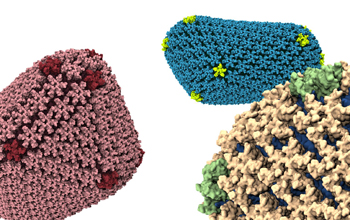Multimedia Gallery
Rendering of HIV capsid with pentamers and hexamers (Image 1)
Three different renderings of the human immunodeficiency virus (HIV) capsid, with multiple colors representing pentamers and hexamers, the bulding blocks of the capsid. Researchers have determined the precise chemical structure of the HIV capsid, a protein shell that protects the virus's genetic material and is a key to its ability to infect and debilitate the human body's defense mechanism.
One of the biggest stumbling blocks to creating truly effective therapies to combat the virus is that the exact structure of the HIV capsid was unknown--until now. Researchers Klaus Schulten and Juan Perilla at the University of Illinois at Urbana-Champaign (UIUC) successfully used the National Science Foundation (NSF)-supported Blue Waters, one of the fastest supercomputers in the world, to create a detailed molecular map of the HIV-1 capsid. The capsid has become an attractive target for the development of new antiretroviral drugs that suppress the HIV virus and stop the progression of AIDS.
The sustained petascale performance of Blue Waters enabled the researchers to explore new methods, combined with structural and electron microscopy data, to reliably model the chemical structure of the HIV capsid in great detail. NSF funding (grants PHY 08-22613, MCB 07-44057 and OCI 07-25070) supported the development of the HIV capsid model, through funding of personnel, equipment and computing resources.
Located at the at the National Center for Supercomputing Applications at UIUC, Blue Waters has been configured to solve the most challenging compute-, memory- and data-intensive problems in science and engineering. It has tens of thousands of chips (CPUs and GPUs), more than a petabyte of memory, tens of petabytes of disk storage and hundreds of petabytes of archival storage.
To learn more about this research and view videos, see the NSF press release Cracking the code of HIV; providing an up-close view of the enemy. To learn more about Blue Waters, see the NSF press release NSF-supported Blue Waters, one of the world's most powerful computers, is open for research. (Date of Image: May 2013) [Image 1 of 4 related images. See Image 2.]
Credit: Theoretical and Computational Biophysics Group (www.ks.uiuc.edu), Beckman Institute for Advanced Science and Technology, University of Illinois at Urbana-Champaign
See other images like this on your iPhone or iPad download NSF Science Zone on the Apple App Store.
Images and other media in the National Science Foundation Multimedia Gallery are available for use in print and electronic material by NSF employees, members of the media, university staff, teachers and the general public. All media in the gallery are intended for personal, educational and nonprofit/non-commercial use only.
Images credited to the National Science Foundation, a federal agency, are in the public domain. The images were created by employees of the United States Government as part of their official duties or prepared by contractors as "works for hire" for NSF. You may freely use NSF-credited images and, at your discretion, credit NSF with a "Courtesy: National Science Foundation" notation.
Additional information about general usage can be found in Conditions.
Also Available:
Download the high-resolution JPG version of the image. (975 KB)
Use your mouse to right-click (Mac users may need to Ctrl-click) the link above and choose the option that will save the file or target to your computer.



